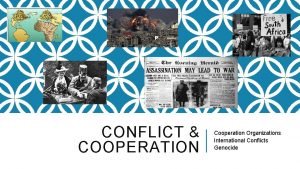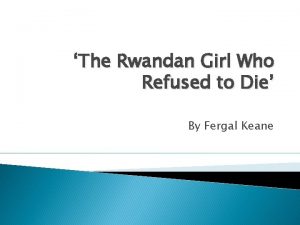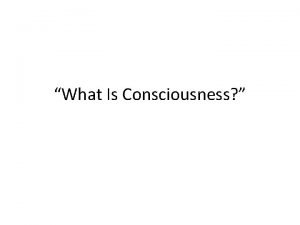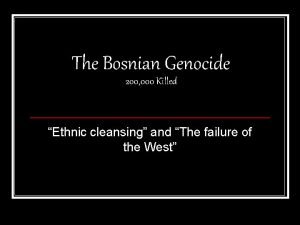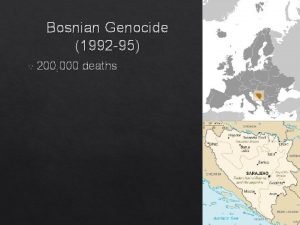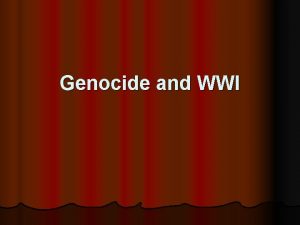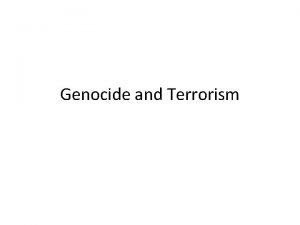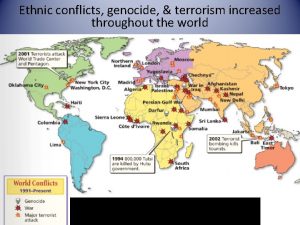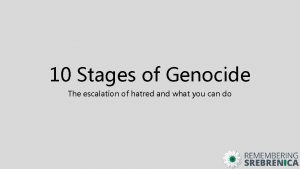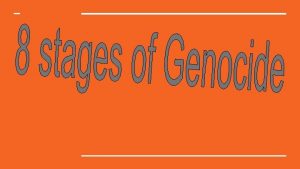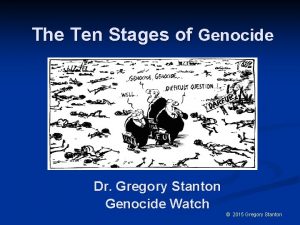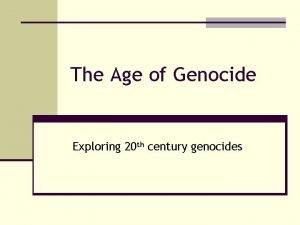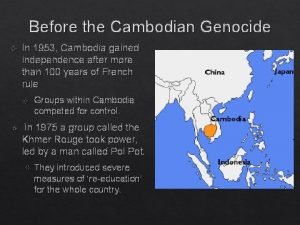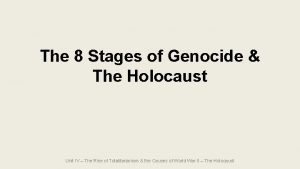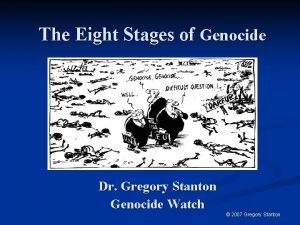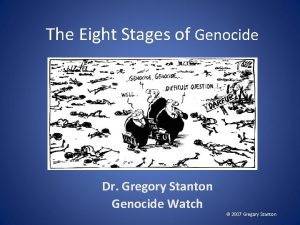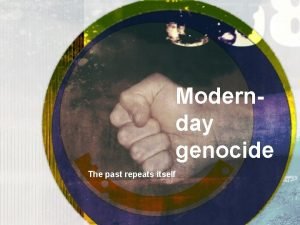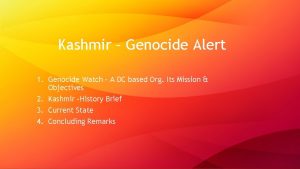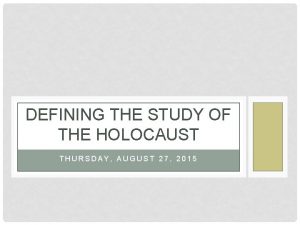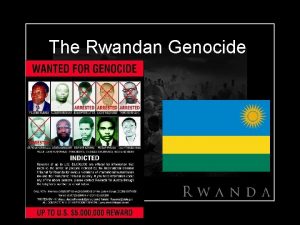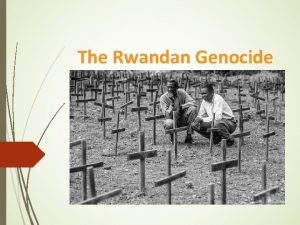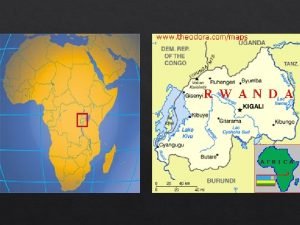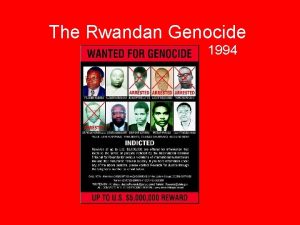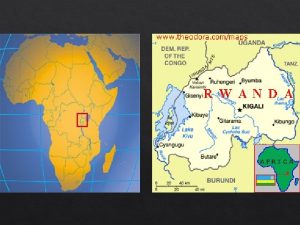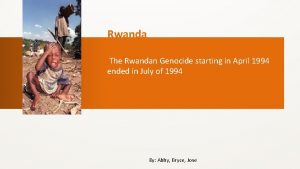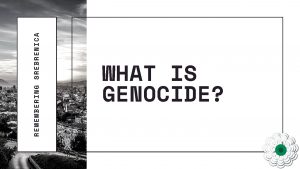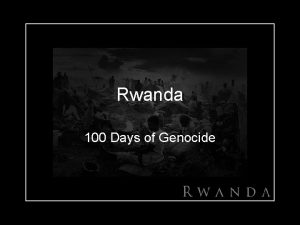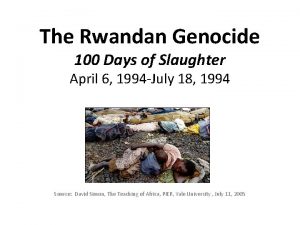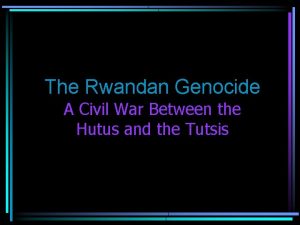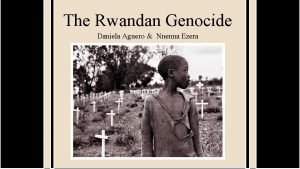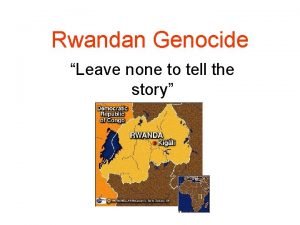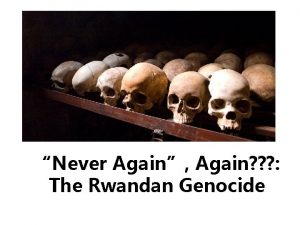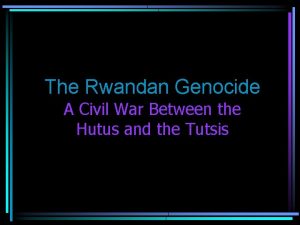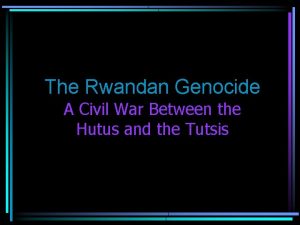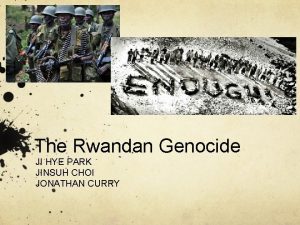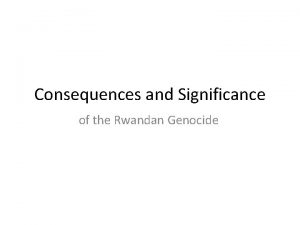1994 Rwandan Genocide David Armstrong University of WisconsinMilwaukee









































- Slides: 41

1994 Rwandan Genocide David Armstrong University of Wisconsin-Milwaukee Christian Davenport Notre Dame University Cyanne Loyle Notre Dame University Allan C. Stam University of Michigan

Rwandan Civil War: Large scale multi-decade civil war 1957 -2002 • Apex of violence in 1994 • Tremendous heterogeneity in killing • Genocide, Politicide, Anarchy, Reprisal Killings • Key event in development of ICC, R 2 P

Rwandan Civil War: Two Histories 1. RPF invades in 1994 to halt genocide, – – RPF and Kagame regime reliable info source 800, 000 -1, 000+ people died Unprecedented scale/pace Basis for RPF political legitimacy 2. Deterrence failure, RPF succeeds in conquest – – – RPF provokes then observes killing (Warsaw Uprising). 250, 000 -400, 000 deaths, 80 -50% victims Tutsi. Scale and pace consistent with past events. Kagame govt uses “data” to legitimize sovereignty claim. Human rights community complicit in inflating data.

Rwandan Civil War: Key Puzzle, RPF Intentions? H 1: RPF invades Rwanda to stop genocide. H 2: RPF invades to conquer Rwanda. Saves few Tutsi. To test hypotheses we need: 1. Data on number of killings 2. Location and date of killings 3. How people died (focus on mass deaths) 4. Estimate of how quickly the RPF could move 5. Data on date and location of RPF area of control

Outline 1. First…context 2. Then…content

Rwanda-Burundi Historical Context 1860 -95 – Rwabugiri Consolidation: feudal patronage, centralized military. 1919 – Versailles: Belgium to govern Ruanda-Urundi. 1946 – Rwanda-Burundi becomes UN trust territory governed by Belgium. 1957 -1963 Hutu Social Revolution: 150 k-270 k Rwandan Tutsi emigrate or killed. 1957 – Hutus issue manifesto, Hutu political parties formed. 1959 – Kristallnacht: Tutsi King Kigeri along with 25 k-75 k Tutsi leave (Uganda). 1963 – Independence: Hutu Pres, 140 k-250 k (30 -80%) Tutsi leave the country. 1963 – 10 -20 k Tutsi killed in Rwanda following failed Tutsi invasion from Burundi. 1972 – 50 -200 k Hutu killed in Burundi: deliberate targeting of elites off name lists 1973 – Military coup in Rwanda led by Juvenal Habyarimana: N. Hutu purge S. Hutu 1988 – 50 k Hutu refugees enter R from Burundi following failed Hutu coup attempt.

1990’s: Groups and Preferences During Civil War Groups: Hx = Hutu Power/Interahamwe Hm= Hutu ‘moderates’ Habyarimana Tr = Tutsi in Rwanda: Francophone Tx = Tutsi Expats in Uganda: Anglophone Preferences: Hm and Tr Hx Tx Prefer to accept Arusha accords Prefer no power sharing with Hm, Tr, or Tx Prefer no power sharing with Hm, Hx, or Tr Hx Bet Wrong: Believe that Tx and Tr have same Pref

Timeline Cont’d: The Civil War 1990 1 st Rwandan Patriotic Front (RPF) invasion from Uganda. 1993 Feb: 2 nd RPF invasion. Creates 1, 000 IDP housed in 40 camps 1993 June: Hutu President elected in Burundi for first time (Buyoya out). 1993 Aug: Arusha Accords: RPF 5/21 ministries, 40% of mil. Elections in 22 mos. 1993 Oct: Burundi Pres (Hutu), cabinet, assassinated by Tutsi soldiers: Coup fails 1993 Nov: Dellaire reports plans and preparations for mass killings 1994 Apr 6: – Habyarimana (Hutu), Burundian pres (Hutu), 8 others, Assassinated – FAR and Interahamwe begin Genocidal campaign – RPF 3 rd Invasion: Launch three pronged offensive 1994 Aug 1: 2 million EDP, 1 million IDP, 1 million (? ) dead: 50% dead or refugee. 1996 Jul 25: Coup in Burundi, Buyoya seizes power: Tutsi restoration complete 1998 – 2000 – RPF gains control of Eastern Congo to Kisangani/Stanleyville.

Q 1: How many died? A U. N. expert evaluating population loss in Rwanda estimated that 800, 000 Rwandans had died between April and July 1994…Seltzer estimated the number of persons killed in the genocide as at least one half million. Professor Gérard Prunier estimated that 130, 000 Tutsi were alive in July, but his figures did not include those in Zaire or Tanzania, perhaps another 20, 000. If this number of 150, 000 survivors is subtracted from an estimated population of 657, 000 Tutsi, this leaves 507, 000 Tutsi killed, close to Seltzer’s minimum assessment. . . Human Rights Watch

Where do the numbers, “estimates” come from? To: seltzer@fordham. edu From: Christian Davenport <christiandavenport@mac. com Date: 10/05/2007 12: 58 PM Subject: Contact and Query Prof. Seltzer, My name is Christian Davenport at the University of Maryland. I have been studying Rwandan political violence for about 10 years and I was curious how you generated your estimation of 500, 000 killed during the violence of 1994. This amount is referenced in the Human Rights Watch book but not in any detail. Was there another paper that was generated on this which discusses the approach that you adopted and data that you employed in greater detail? I look forward to hearing from you. Christian Davenport

I Can’t Remember… From: <seltzer@fordham. edu To: "Christian Davenport" < christiandavenport@mac. com Cc: <seltzer@fordham. edu Date: October 05, 2007 01: 23: 58 PM EDT Subject: Re: Contact and Query Dear Christian, Thank you for your question and your interest. In answer to your first question, the key feature of my estimate of "more than 500, 000 deaths" was not the specific figure of 500, 000 but the words "more than. "…The figure "more than 500, 000" was modeled on the notion that estimate of "about" or "at least" 6, 000 died in the Holocaust was sufficient for the Nuremberg prosecution. I can no longer recall why I settled on 500, 000 as the lower anchor of my estimate… On your second question, I do remain interested in the subject. A number of my recent related writings on the subject can be found at http: //www. uwm. edu/~margo/govstat/integrity. htm Again, thank you very much for your interest. Regards Bill

Our Data: Deaths Whole Country Yes 1. Ministry of Education Yes Only Large Scale Killing 2. Ministry of Youth, Culture and Sport No 1. Physicians for Human Rights 2. Human Rights Watch 1. Ruzibiza Deposition No 1. Ministry of Local Affairs 1. Ibuka/Verwimp 2. ICTR Witness Testimony 2. African Rights 3. Aegis Trust

The Data Imputation Problem… Bayes estimator provides a possible solution Minaloc Commune (Accounted) Africa Rights Min of Ed Min of YCS HRW IBUKA Verwimp Gitesi 13, 522 54, 401 -- 5, 000 -- 11, 118 133 Gishyita 13, 448 23, 110 15, 000 400 5, 000 11, 273 2, 883 Ndora 12, 417 -- -- 6, 000 -- -- 1, 864 Sake 11, 316 -- -- 3, 650 -- -- 198 Mabanza 10, 627 19, 500 -- 73, 465 -- 8, 782 3, 362 Bwakira 5, 488 -- -- 4, 674 1, 219 Kivumu 5, 253 1 -- -- -- 3, 934 3, 151 Gisovu 4, 642 -- 37 -- -- 3, 003 680 Shyanda 4, 536 23, 500 21, 140 1, 000 -- -- 8, 933 Sum 81, 249 120, 512 36, 177 89, 515 5, 000 42, 784 22, 423

Imputing an estimate: Commune-Day data

Exhumation of Kibuye Church

Challenge to Data Imputation Kibuye Church Exhumation: • Civilians massed 4/8 -17 • 8, 000: counted for food • 6, 000: number of victims claimed by burial witnesses • 493: number exhumed 80 k total dead? • 6: number of ID cards recovered Do have confidence in relative intensity of Killings • Visited sig proportion of mass killings sites. All exist.

800 How Many Tutsi Died? Start with Rwanda Tutsi Population Estimates 700 647 Seltzer's Estimate 601 600 500 403, 000 Tutsi (15% of UN pop estimate of 2. 7 million) 506 Rwanda census 467 tutsi pop 1. 8% growth- UNHRC refugees 400 tutsi pop 2. 5% growth - UNHCR refugees 319 302 300 tutsi median 59 -63 exodus (200 k) + 2. 5% growth 200 100 0 1953 1958 1963 1968 1973 1978 1983 1988 1993 1998

How Many Hutu Died? Estimating Victim Counts Assumptions: Tutsi Population 19932 …………. . 506, 000 Tutsi Survivors 5 …………. . 300, 000 Tutsi Victims …………. . 206, 000 Total Victims Hutu Victims 6 Bayes Low End 270, 000 64, 000 Bayes Median 430, 000 224, 000 Bayes Plausible High End 614, 000 408, 000 Ministry of Education, (1995 -6) 721, 000 515, 000 Human Rights Watch 4 (1995 -6) 800, 000 594, 000 Ministry of YCS (1995) 834, 000 628, 000 2000 Govt Census 1 (MINALOC 2000) 934, 000 728, 000 1, 260, 000 1, 054, 000 Deaths by Data Source 1998 Govt survey Notes: 1. The Rwanda government conducted a new genocide victims census from July 17 -27, 2000. The figures draw on that survey. We report accounted for victims vs. declared. 2. William Seltzer puts the 1994 Tutsi population at 647, 000. De Forge, pg 15. We use 2. 5% growth mode accounting for UNHCR refugee data. 3. De Forge estimates that roughly 500, 000 died as a result of genocide, and another 300, 000 as a result of other violence. Leave None, pg 16. 4. De Forge estimates that 150, 000 Tutsi survived. Leave None, pg 24. 5. Minaloc survey counted 283, 000, Ibuka estimates 350, 000. 2007 Rwanda government report suggests 309, 000, Gacaca court survey estimates 327, 000. 6. Assuming 206, 000 Tutsi dead

Sidebar Q 2: How could so many Hutu have been killed?

Deception and Mistaken ID 1. During previous mass killings, municipal structures were places of Refuge for both H and T 2. Identification of ethnic ID problematic away from home “hill. ”

Who’s a Hutu, Who’s a Tutsi?

DR. HIERNAUX SCIENTIFIC EXPERIMENTS TO DISTINGUISH BAHUTU AND BATUTSI (1954) 1. Head length 2. Head width 3. Facial diameter 4. Facial height 5. Nose height 6. Nose size 7. Nose width 8. Nose depth 9. Eye brows size 10. Eye lashes size 11. Lips height 12. Lips width 13. Ears height 14. Ears width 15. Head height 16. Cranial size 17. Cranial mass 18. Body height 19. Body height sitted 20. Body weight 21. Body/height ratio 22. Arms length 23. Arms /body height ratio 24. Humerus length 25. Radius length 26. Radius/humerus ratio Belgian Phrenology: 1920’-30’s Hutu Tutsi 27. Tibia length 28. Shoulders diameter 29. Shoulders height ratio 30. Chest size 31. Chest size height ratio 32. Body weight 33. Body height/weight ratio 34. Arms size (stretched) 35. Arms size (folded) 36. Thighs size 37. Body strength 38. Skin color 39. Degrees of skin color tone 40. Color of eyes 41. Color of hair 42. Form of hair 43. Blood groups (ABO) 44. Blood groups (Rh) 45. Sickle cell trait 46. Color blindness 47. Taste (Sensibilite au Phenylthiocarbamide) 48. Heart beat rate 49. Respiration rate 50. Blood pressure 51. Dental structure 52. Dental abnomalties

Q 3: Where, when, and how did people die?

Where and When Killing Took place • ICTR data: 15, 000 witness statements – Scanned – OCR’d – Translated – Content analysis for action, weapon, date, location • MINELOC, YCS, HRW, IBUKA, AR • Bayes estimate of date, location – Estimates are probabilistic statements

How People Died • • Mass Killings: Name lists: Roadblocks: Local Violence: RTLM exhortation: RPF retribution: Total: 100, 000 – 750, 000 25, 000 – 100, 000 0 – 50, 000 25, 000 – 150, 000 200, 000 – 1, 250, 000

H 1 and H 2: Did the RPF Stop the killing? Culpability is unclear in many cases. Focus on mass killings which are best documented: We need to know two more things: 1. Where the RPF was 2. When they got there

Where the two armies were… • Began with DIA estimates from Kuperman • Updated with CIA NIE (declassified 2001) • Updated by Paul Ruzibiza (Former RPF staff) • Cross checked by 4 former RPF members • Cross checked by FAR defendants

RPF Advance: 1994

Invasion and Genocide

Could the RPF have moved quickly enough? 1. How big is Rwanda? • Size of NH/VT 2. How big are Rwanda Provinces (prefectures)? • Size of US counties 3. Facing little resistance, RPF could traverse 25 miles in one day on foot 4. Interahamwe routinely traversed half of country in trucks within hours to carry out mass killings. 5. RPF on foot could cross > 1 Province a day if no resistance

Rwanda in Geographic Context

Rwanda in Geographic Context

Kigale Rurale: Site of active fighting until end of June 20 000 100% 18 000 90% 16 000 80% 14 000 70% 12 000 60% Bayes Median 10 000 Deaths 50% RPF Control of Province 8 000 40% 6 000 30% 4 000 20% 2 000 10% 0 3. 16. 94 4. 5. 94 4. 25. 94 5. 15. 94 6. 4. 94 Date 6. 24. 94 7. 14. 94 8. 3. 94 0% 8. 23. 94

Kibungo: Large scale mass killing of Eastern Tutsi Monastery mass killing 8 000 100% 90% 7 000 80% 6 000 70% 5 000 60% Bayes Median 4 000 Daily Deaths 50% 40% 3 000 30% 2 000 20% 1 000 0 3. 16. 94 10% 4. 5. 94 4. 25. 94 5. 15. 94 6. 4. 94 Date 6. 24. 94 7. 14. 94 8. 3. 94 0% 8. 23. 94 RPF Control of Province

Butare: National University and Largest Tutsi Population 45 000 100% 40 000 90% 80% 35 000 70% 30 000 60% Bayes Median Deaths 25 000 50% 20 000 40% 15 000 30% 10 000 20% 5 000 0 3. 16. 94 10% 4. 5. 94 4. 25. 94 5. 15. 94 6. 4. 94 Date 6. 24. 94 7. 14. 94 8. 3. 94 0% 8. 23. 94 RPF Control Of Province

Kibuye: Location of significant armed Tutsi Resistance 20 000 35% 18 000 30% 16 000 25% 14 000 12 000 20% Bayes Median 10 000 Deaths RPF Control Of Province 15% 8 000 6 000 10% 4 000 5% 2 000 0 3. 16. 94 4. 5. 94 4. 25. 94 5. 15. 94 6. 4. 94 Date 6. 24. 94 7. 14. 94 8. 3. 94 0% 8. 23. 94 Operation Turquoise



Q 5: Best Comparison Cases? 1. Genocide as part of larger war – Warsaw uprising – 1992 Shi’ia uprising in Iraq – Example of jews from Bruce 2. Genocide during Emergence from Feudalism – Genocide, Politicide, Anarchy, Chaos in: • • English Civil War Russian Civil War Chinese Civil War Rwanda Civil War…

Project Team Christian Davenport, University of Notre Dame, Political Science Allan Stam, University of Michigan, Political Science David Gadsen, ESRI and Arcview David Armstrong, University of Wisconsin-Milwaukee Peter Erlinder, ICTR Defense, William Mitchell College of Law Barbara Mulvaney, ICTR Prosecution, Former New Mexico States Attorney Donald Webster, ICTR Prosecution, Former NYC District Attorney Cyanne E. Loyle, Graduate Fellow, University of Notre Dame Anthony Bramante, GIS Lab tech, Dartmouth College Nick Greenfield, Graduate Student, Brown University Cali Ellis, Graduate Student, University of Michigan

Questions?
 North korea genocide 1948-1994
North korea genocide 1948-1994 The rwandan girl who refused to die
The rwandan girl who refused to die Kinyarwanda proverbs
Kinyarwanda proverbs David armstrong philosopher
David armstrong philosopher Bosnian genocide death toll
Bosnian genocide death toll Genociden
Genociden Nazi europe
Nazi europe The deliberate killing of a large group of people
The deliberate killing of a large group of people Bosnian genocide classification
Bosnian genocide classification Cultural genocide china
Cultural genocide china Define genocide
Define genocide Define genocide
Define genocide Genocide
Genocide Barotrauma genocide
Barotrauma genocide 10 stages of genocide
10 stages of genocide Genocide
Genocide Genocide
Genocide Ten stage of genocide
Ten stage of genocide Cambodia map
Cambodia map Genocide definition
Genocide definition Genocide definition
Genocide definition Genocide
Genocide Cambodian genocide blue scarf
Cambodian genocide blue scarf Zunghar genocide
Zunghar genocide Rosie the riveter country
Rosie the riveter country The genocide politics know
The genocide politics know Lenin genocide
Lenin genocide True himmler david irving
True himmler david irving Genocide
Genocide Leopold african genocide
Leopold african genocide The eight stages of genocide
The eight stages of genocide Dr gregory stanton
Dr gregory stanton Rwanda genocide map
Rwanda genocide map Past tense of genocide
Past tense of genocide Plebiscite etymology
Plebiscite etymology Deuteronomy 20:8
Deuteronomy 20:8 What does peter drost define genocide as?
What does peter drost define genocide as? Michael collins buzz aldrin and neil armstrong
Michael collins buzz aldrin and neil armstrong Captive pricing
Captive pricing Customer driven marketing strategy
Customer driven marketing strategy How does the squirrel wore an overcoat of gray
How does the squirrel wore an overcoat of gray Interesting facts about neil armstrong childhood
Interesting facts about neil armstrong childhood
